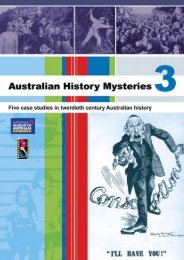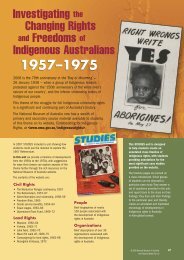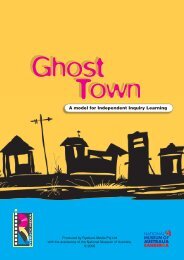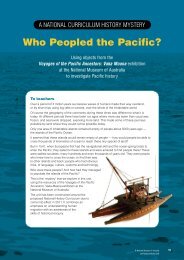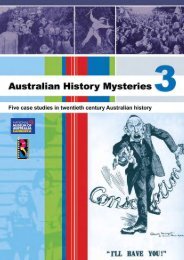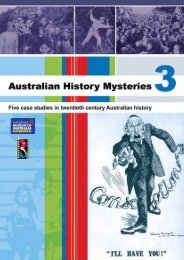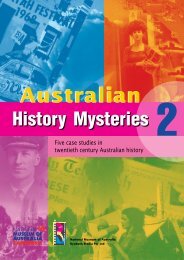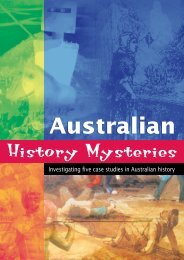Download Teacher Guide & Print Resources - Australian History ...
Download Teacher Guide & Print Resources - Australian History ...
Download Teacher Guide & Print Resources - Australian History ...
Create successful ePaper yourself
Turn your PDF publications into a flip-book with our unique Google optimized e-Paper software.
Activity page<br />
7C<br />
Source 7<br />
Though agriculture had become established, and the<br />
colony was no longer prey to desperate shortages,<br />
the quantity of food produced was still very small, and<br />
its production erratic. Droughts and floods caused<br />
fluctuating harvests; grain was still being imported,<br />
from Van Diemen’s Land one year, from India another.<br />
Sydney had founded its urban satellites early: the first<br />
was Norfolk Island, the second Parramatta; then the<br />
Green Hills on the Hawkesbury grew up as a military<br />
and service centre for the river farms near the mountain<br />
frontier. The search at sea continued, though the main<br />
body of settlers at Norfolk Island was removed to Van<br />
Diemen’s Land in 1808 and the island abandoned in<br />
1813. Newcastle, at the mouth of the Hunter River,<br />
became a convict depot, formed to isolate secondary<br />
offenders and exploit the coal, timber and shell-lime<br />
resources rather than to establish farming. Bass and<br />
Flinders had explored the southern coast; Port Phillip<br />
was known, briefly settled and then rejected by David<br />
Collins in favour of Hobart on the Derwent, which was<br />
strategically placed in the south to catch the vessels<br />
taking advantage of the ‘Roaring Forties’ spinning<br />
around the Antarctic seas.<br />
So the urban pattern remained centred on Sydney,<br />
but most of the secondary settlements were more like<br />
strategic satellites than agrarian centres. What is more,<br />
they were isolated at considerable distances from each<br />
other, and little or nothing was known of the land in<br />
between.<br />
James Broadbent and Joy Hughes (eds), The Age of Macquarie,<br />
Melbourne University Press, 1992, p. 66<br />
7 What other settlements existed apart from Sydney<br />
by 1813?<br />
8 Why were these not suitable for a large expansion<br />
of food or grazing?<br />
Source 8<br />
Blaxland and his elder brother John were immigrants<br />
from Kent, to whom liberal grants of land had been<br />
made on condition that they invested capital in New<br />
South Wales and engaged in agriculture. But they<br />
preferred to apply themselves to what Governor<br />
Macquarie called ‘the lazy object of rearing cattle’. They<br />
understood cattle-breeding and found it profitable,<br />
whereas Macquarie desired that settlers who obtained<br />
land grants should grow corn. The Blaxlands, working<br />
in partnership, wanted extensive areas for their herds;<br />
and whenever an area suitable for pasture came under<br />
their notice, they were prompt to apply for a slice,<br />
whilst the Governor was equally prompt to refuse them.<br />
They therefore had a pressing motive for ascertaining<br />
whether there was good cattle country beyond the<br />
limits of settlement. Gregory Blaxland had been on two<br />
exploring expeditions — the first of them in company<br />
with Macquarie — before he projected the enterprise of<br />
1813. In that year a severe drought afflicted the colony.<br />
No rain fell during what was normally the wet season.<br />
The greater part of the seed sown produced no crops,<br />
and ‘an alarming mortality’ occurred among the flocks<br />
and herds, It was therefore especially necessary to<br />
make an effort to find out whether there was fodder and<br />
water on the western side of the range.<br />
Ernest Scott (ed.), Australia, vol. VII, part 1 of the<br />
Cambridge <strong>History</strong> of the British Empire, Cambridge, 1988, p. 109<br />
9 What motives are being suggested here for<br />
crossing the Blue Mountains?<br />
10 You have now seen several possible reasons why<br />
explorers tackled the crossing in 1813. Which do<br />
you think most important?<br />
11 In question 1 you might have considered such<br />
things as curiosity, adventure or greed as<br />
reasons for the explorers’ desire to cross the<br />
Blue Mountains. Do you still think these might<br />
have been significant? Justify your views.<br />
12 Add any information to your<br />
summary table on activity page 3A.<br />
13 Write a brief paragraph or do a<br />
comic strip sketch for your own<br />
history textbook (in box 3 of activity page 3B)<br />
to explain to readers why the explorers wanted<br />
to cross the Blue Mountains in 1813.<br />
The crossing of the Blue Mountains in 1813 was done in response to the<br />
stimulus for wool created by the Industrial Revolution in Britain. True or False?<br />
Myths and Mysteries of the Crossing of the Blue Mountains<br />
23




